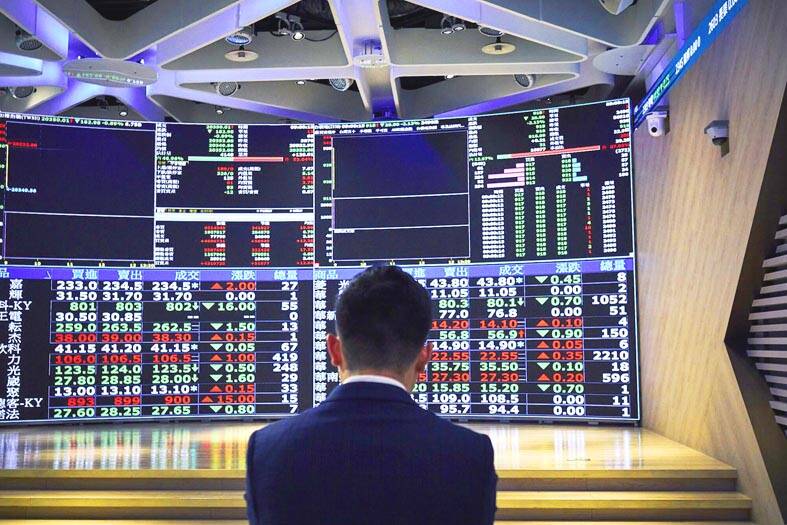Taiwanese investors are reassessing their long-held preference for US-dollar assets, shifting their bets to Europe in the latest move by global investors away from the greenback.
Taiwanese funds holding European assets have seen an influx of investments recently, pushing their combined value to NT$13.7 billion (US$461 million) as of the end of last month, the highest since 2019, according to data compiled by Bloomberg.
Over the first half of this year, Taiwanese investors have also poured NT$14.1 billion into Europe-focused funds based overseas, bringing total assets up to NT$134.8 billion, according to data from the Securities Investment Trust and Consulting Association (SITCA), the largest six-month injection since 2021.

Photo: An Rong Xu, Bloomberg
At the same time, Taiwan-based funds focusing on the US saw their combined value fall by NT$538 billion over the first half of the year, the largest six-month decline since Bloomberg first started compiling the data in 2003. Taiwanese assets in US-focused overseas funds declined by NT$121.6 billion, the biggest contraction since SITCA records began in 2006.
The shift represents a pivotal moment for Taiwan’s wealthy institutional investors, which have until now overwhelmingly favored the US when allocating money overseas. Taiwan is the 11th largest foreign holder of US Treasuries. The country’s investors held US$292.9 billion in US government bonds as of the end of May, according to the US Department of the Treasury’s data.
That is US$5.9 billion less than in April, the biggest monthly decrease since September 2022.
The change is not limited to Taiwan. US President Donald Trump’s tariff barrage, the growing budget deficit and widening political polarization have prompted Asia’s major exporting economies to seek alternatives for the combined US$7.5 trillion they have invested in US equities and debt.
“Institutional investors such as the banks and life insurers are moving their assets very quickly,” said Agnes Lin (林雅慧), markets strategist at JPMorgan Asset Management, which manages Taiwan’s largest Europe-focused fund. “It’s clear they have a strategy to diversify their allocations over the long term.”
Lin expects Taiwan’s retail investors to start focusing on the region as well if European shares extend their gains until next year.
More than 90 percent of the NT$22 trillion that Taiwan’s life insurance companies have invested overseas is in US dollars, Financial Supervisory Commission data showed.
This concentration in US dollar-denominated assets presents a huge foreign exchange risk for these companies. The New Taiwan dollar’s historic surge against the greenback in early May caused combined foreign-exchange losses of more than NT$145 billion for local insurers.
Retail investors in US bond-focused exchange-traded funds were also affected by the currency’s dramatic appreciation, prompting renewed debate in Taiwan over the need for greater diversification.
The NT dollar has appreciated more than 10 percent versus the greenback so far this year, compared with a 0.9 percent depreciation versus the euro.
BNP Paribas Wealth Management for Asia-Pacific chief executive officer Arnaud Tellier said Taiwan’s wealthy families were shaken by the volatility in the local currency.
“We see now they really look at diversifying outside of US-denominated assets,” he said in a statement. “We see lots of questions about other currencies starting with the euro.”

Taiwan Semiconductor Manufacturing Co (TSMC, 台積電) last week recorded an increase in the number of shareholders to the highest in almost eight months, despite its share price falling 3.38 percent from the previous week, Taiwan Stock Exchange data released on Saturday showed. As of Friday, TSMC had 1.88 million shareholders, the most since the week of April 25 and an increase of 31,870 from the previous week, the data showed. The number of shareholders jumped despite a drop of NT$50 (US$1.59), or 3.38 percent, in TSMC’s share price from a week earlier to NT$1,430, as investors took profits from their earlier gains

In a high-security Shenzhen laboratory, Chinese scientists have built what Washington has spent years trying to prevent: a prototype of a machine capable of producing the cutting-edge semiconductor chips that power artificial intelligence (AI), smartphones and weapons central to Western military dominance, Reuters has learned. Completed early this year and undergoing testing, the prototype fills nearly an entire factory floor. It was built by a team of former engineers from Dutch semiconductor giant ASML who reverse-engineered the company’s extreme ultraviolet lithography (EUV) machines, according to two people with knowledge of the project. EUV machines sit at the heart of a technological Cold

Taiwan’s long-term economic competitiveness will hinge not only on national champions like Taiwan Semiconductor Manufacturing Co. (TSMC, 台積電) but also on the widespread adoption of artificial intelligence (AI) and other emerging technologies, a US-based scholar has said. At a lecture in Taipei on Tuesday, Jeffrey Ding, assistant professor of political science at the George Washington University and author of "Technology and the Rise of Great Powers," argued that historical experience shows that general-purpose technologies (GPTs) — such as electricity, computers and now AI — shape long-term economic advantages through their diffusion across the broader economy. "What really matters is not who pioneers

TAIWAN VALUE CHAIN: Foxtron is to fully own Luxgen following the transaction and it plans to launch a new electric model, the Foxtron Bria, in Taiwan next year Yulon Motor Co (裕隆汽車) yesterday said that its board of directors approved the disposal of its electric vehicle (EV) unit, Luxgen Motor Co (納智捷汽車), to Foxtron Vehicle Technologies Co (鴻華先進) for NT$787.6 million (US$24.98 million). Foxtron, a half-half joint venture between Yulon affiliate Hua-Chuang Automobile Information Technical Center Co (華創車電) and Hon Hai Precision Industry Co (鴻海精密), expects to wrap up the deal in the first quarter of next year. Foxtron would fully own Luxgen following the transaction, including five car distributing companies, outlets and all employees. The deal is subject to the approval of the Fair Trade Commission, Foxtron said. “Foxtron will be